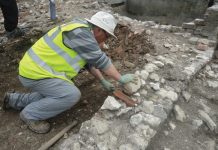‘Black Gold’ in Hardy’s Wessex – the surprising story of oil in Dorset by Philip Strange
It’s difficult to believe but one of the most beautiful parts of Dorset is home to the largest on-shore oil field in Western Europe. And yet the day to day impact on most residents and on the local environment is minimal. Perhaps the Dorset oil experience can help us predict the potential environmental effects of shale gas extraction by fracking in other parts of the UK? Let’s look at the story of oil in Dorset and see what we can learn.
Kimmeridge Coal
Medieval times were harsh for most people but if you lived near Kimmeridge Bay in the Isle of Purbeck, you had one thing going for you; some of the rocks exposed in the cliffs would burn so you had a ready-made fuel for heating and cooking. The locals called it ‘Kimmeridge Coal’ and it didn’t matter that it smelt awful, it was available and it was free. The same logic drove Sir William Clavell in the 17th century to set up alum works at Kimmeridge using the fuel. His efforts came to nothing because of patent restrictions so he turned to making salt by boiling sea water and subsequently he set up a glass works, but neither enterprise prospered.
‘Kimmeridge Coal’ is found in bands of bituminous shale in the cliffs around Kimmeridge Bay but further exploitation of the material had to wait until the 19th century when it was realised that useful hydrocarbons might be extractable. Processing plants were set up at Weymouth and at Wareham making varnish, grease, pitch, naphtha, paraffin and paraffin wax and in 1848 the street lights of Wareham were lit by 130 lamps powered by gas derived from the shale. The industry never prospered, possibly because the high sulphur content made the gas unsuitable for domestic use.
Kimmeridge oil shale is a useful material but it is not a source of conventional crude oil. Ironically, the first discovery of crude oil in Dorset also occurred at Kimmeridge Bay but it comes from rocks lying well below the shale deposits.
The Kimmeridge ‘nodding donkey’
The search for oil in Dorset began in the 1930s but it was not until 1959 that the first well producing oil and gas was discovered below Kimmeridge Bay. The well is extracted by a single beam ‘nodding donkey’ pump on the cliffs above the Bay that has worked continuously for more than 50 years; it is the oldest working oil well in the UK and the “nodding donkey” is now part of the local scenery. The Kimmeridge well produced 350 barrels of oil a day at its peak but this has now declined to a fifth of that level. Although the Kimmeridge reservoir is not large, the discovery prompted the search for other oil deposits in Dorset.
The largest on-shore oil field in Western Europe – hidden near Poole Harbour
The energy crises of the 1970s led to further exploration in Dorset and in 1974, oil and gas were discovered by the Gas Council at Wytch Farm on the southern side of Poole Harbour. Production started in 1979 and nowadays the Anglo-French company Perenco owns the majority stake in the oil field. There are three large reservoirs of oil 1-2 km below the sea, extending up to 10 km under Poole Harbour, Brownsea Island, Sandbanks and to the south of Bournemouth. Peak production was in 1997 at 110,000 barrels of oil per day; current levels are about 18,000 barrels per day. The field also produces natural gas (for domestic use) and liquid petroleum gas. There are 12 well sites distributed around Wytch Farm, the Goathorn Peninsula and Furzey island from which more than 100 wells have been drilled. There is also a gathering station where the products of the wells are collected, processed and distributed. This is a large industrial enterprise, the largest on-shore oil field in Western Europe and the second largest consumer of electricity in the South of England (after Heathrow Airport).
The paradox is that this industrial complex operates in an Area of Outstanding Natural Beauty so the site has been developed with this is mind. Buildings are on sites that have been excavated to reduce height and are screened by trees. Facilities are painted a dull brown and the number of well sites has been minimised by drilling long distances horizontally away from the well site in to the oil deposits; until 2008 Wytch Farm held the world record for the longest drill extending 10.1 km under Poole Bay. In consequence, this large industrial complex has minimal impact on the surrounding countryside and most people are unaware of the activity.
Lessons from Dorset oil
Wytch Farm is a great success story, both in terms of the oil and gas produced and the minimal environmental impact. Some have used the Wytch Farm experience to suggest that fracking (hydraulic fracturing for shale gas) in other parts of the UK will also have a minimal environmental impact, even suggesting, incorrectly, that fracking has already occurred at Wytch Farm.
Although similar drilling technology is used to extract crude oil and to release shale gas, fracking uses large volumes of high pressure liquid (mostly water) to create fissures in low permeability rock and this has not been carried out at Wytch Farm. Also each potential fracking site is likely to be unique and different from Wytch Farm in terms of the density of wells required, the density of population and the nature of the countryside. Dorset oil has been managed to minimise environmental impact but it would be wrong to use the Dorset oil experience to predict the general environmental impact of fracking elsewhere.
Here is a link to a complementary article on Dorset Oil: https://philipstrange.wordpress.com/2016/03/23/the-oil-well-and-the-beach-a-clash-of-the-human-and-the-natural-at-kimmeridge-bay/









